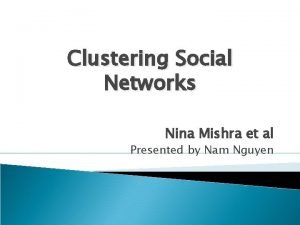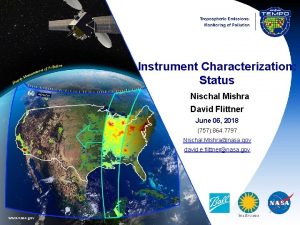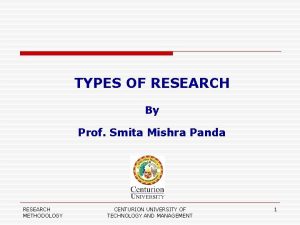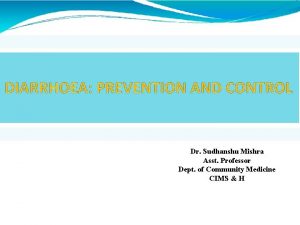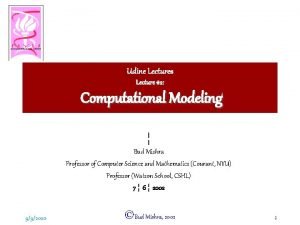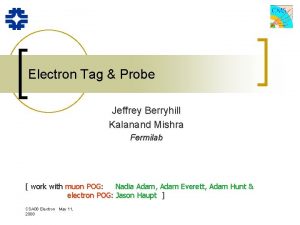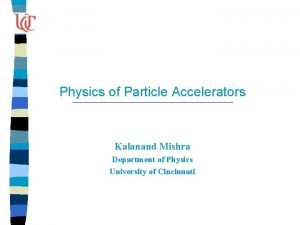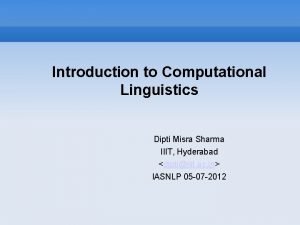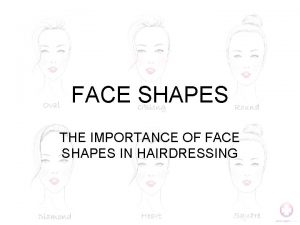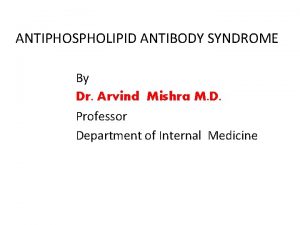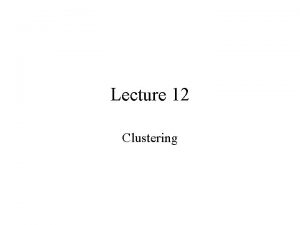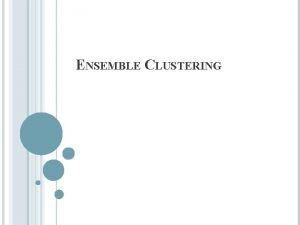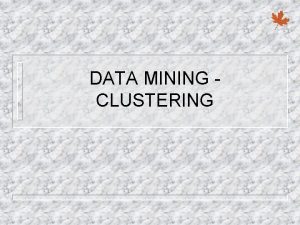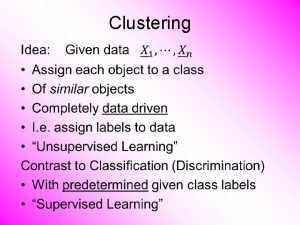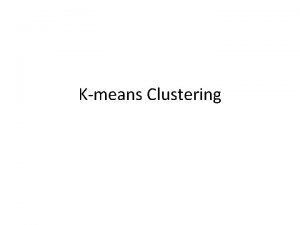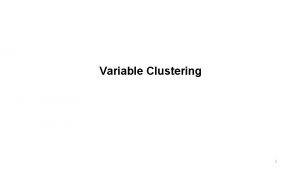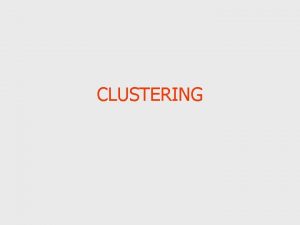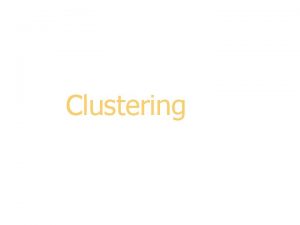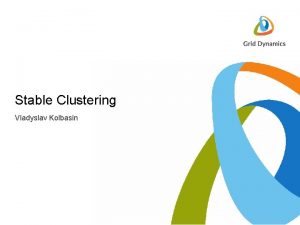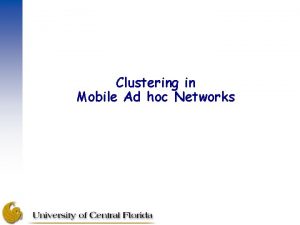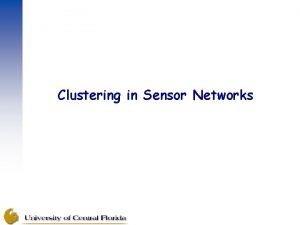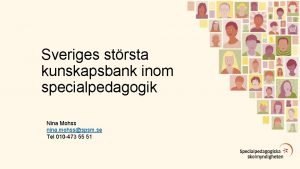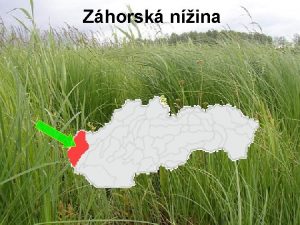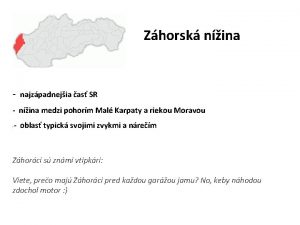Clustering Social Networks Nina Mishra et al Presented


















![References � [1] Clustering Social Networks, Ninna Mishra, Robert Schreiber, Isabelle Stanton and Robert References � [1] Clustering Social Networks, Ninna Mishra, Robert Schreiber, Isabelle Stanton and Robert](https://slidetodoc.com/presentation_image/2a31ebc7a847e4756144c5198c95676b/image-19.jpg)
- Slides: 19

Clustering Social Networks Nina Mishra et al Presented by Nam Nguyen

(α, β)-Cluster � Definition ◦ Given a graph G = (V, E) where every vertex has a self-loop, C ⊂ V is an (α, β)-cluster if 1. Internally dense: ∀v ∈ V, |E(v, C)| ≥ β|C| 2. Externally sparse: ∀u ∈ VC, |E(u, C)| ≤ α|C| u ≤ α|C| ≥ β|C| v

Example � {a, b, c, d} and {d, e, f, g} are (1/4, 1)-clusters � h and i are do not fall into any (α, β)-cluster for 0≤ α< ½ < β ≤ 1 thus, they would not be clustered. (α, β)-cluster are able for detecting overlapping clusters.

Problem definition Objective Identify clusters that are internally dense, i. e. , each vertex in the cluster is adjacent to at least a β-fraction of the cluster, and externally sparse, i. e. , any vertex outside of the cluster is adjacent to at most an α– fraction of the vertices in the cluster. Given 0≤ α< β ≤ 1, find all (α, β)-clusters in the network

Contributions of the paper � Give a bound for the overlapping of two (α, β)clusters A and B. ◦ They overlap in at most |C|*min{1 -(β- α), α/(2β-1)} vertices. � If the ratio of |A| and |B| is at most (1 - α)/(1 - β) then one cluster can not be contained in the other. � Give a loose upper bound for the number of (α, 1)clusters of size s: O( (n/s) α+1 ) � Introduction of the ρ-champion of a cluster and if β> ½(1+ ρ+ α), there is a simple deterministic algorithm for finding all such clusters in time O(m 0. 7 n 1. 2 + n 2+o(1))

Some minor remarks �β 1, the cluster C a clique � α 0, C tends to a disconnected component � β< ½ then C might contain two disconnected components. � We want α < β and β> ½. � (0, β)-clusters finding connected components & output β-connected ones. � (1 -1/n, 1)-clusters finding the maximal cliques in a graph. � ((1 -ε) β, β)-clusters finding quasi-cliques.

Result 1 � Question: ◦ How about the intersection of 3 (or more) (α, β)-clusters of the same size? different size ? ◦ How about the intersection of an (α, β)-cluster and an (α’, β’)-cluster of the same size? different size ?

Result 2: Bounding the number of (α, 1)-clusters � Proof ◦ Two clusters of the same size s can share at most αs vertices. ◦ Every subset of size (αs+1) must appear in at most one set in C. ◦ There are subsets of s elements from n elements, each of these contains subsets of size (αs+1). ◦ Therefore, we can have at most clusters in C ◦ |C| ≤ =

This bound is tight … � when α=0 ◦ No overlapping # of clusters of size s = n/s. � when α 1 ( α = (n-1)/n ) ◦ Consider the complement of the following graph ◦ Let s = n = N/2, then the bound is 2 n. ◦ In fact, we do have 2 n subsets of (α, 1)-clusters of size n by choosing from the set B = {b 1 b 2…bn | bi is either xi or yi}

An algorithm for finding clusters with champions � Why? ◦ In last example, each vertex has as many neighbors outside as within the cluster ◦ There is no vertex that “champions” the cluster (having more friends inside than outside) ◦ Why not find one who champions and start with it?

Algorithm (cont’d) � Assumption: ◦ A big gap between β and α/2: β > ½ + (α+ρ)/2 � Why? ◦ Recall last example: We have 2 n possible clusters of size n Too many ◦ Any algorithm that outputs more clusters than nodes are undesirable. ◦ Thus, we need some restriction to reduce the # of returned clusters.

Algorithm (cont’d) � How many clusters with ρ-champion should we have ? � How to find them? ◦ A big gap between β and α/2: β > ½ + (α+ρ)/2

Algorithm (cont’d) If v and c have sufficient many neighbors then v is a part of the cluster C that c champions. that’s what line #5 for Running time of the algorithm

Experimental Results � For real networks ◦ Do (α, β)-clusters with ρ-champion exist? use Tsukiayama algorithm ◦ If they do exist, do most (α, β)-clusters have ρ-champion? � Results ◦ Able to find ~90% of the maximal cliques in graphs where α ≤ ½. ◦ No strong ρ-champions in missed clusters. ◦ Running time: Weight faster than Tsukiyama’s algorithm � Datasets ◦ High Energy Physics Theory Co-Author graph (HEP) ◦ Theory Co-Author graph (TA) ◦ A subset of Live Journal graph (LP)

Results

Results

Results

Results
![References 1 Clustering Social Networks Ninna Mishra Robert Schreiber Isabelle Stanton and Robert References � [1] Clustering Social Networks, Ninna Mishra, Robert Schreiber, Isabelle Stanton and Robert](https://slidetodoc.com/presentation_image/2a31ebc7a847e4756144c5198c95676b/image-19.jpg)
References � [1] Clustering Social Networks, Ninna Mishra, Robert Schreiber, Isabelle Stanton and Robert E. Tarjan (2007)
 Nina mishra
Nina mishra Flat clustering vs hierarchical clustering
Flat clustering vs hierarchical clustering Partitional clustering vs hierarchical clustering
Partitional clustering vs hierarchical clustering Euclidean distance rumus
Euclidean distance rumus David von flittner
David von flittner Dr anup mishra herbalife
Dr anup mishra herbalife Smita mishra panda
Smita mishra panda Dr sudhanshu mishra
Dr sudhanshu mishra Bud mishra
Bud mishra Kalanand mishra
Kalanand mishra Kalanand mishra
Kalanand mishra Lasert tag
Lasert tag Kirti mishra
Kirti mishra Ans
Ans Dr padma mishra bhopal
Dr padma mishra bhopal Tooth 10 and 11
Tooth 10 and 11 Virtual circuit approach
Virtual circuit approach Backbone networks in computer networks
Backbone networks in computer networks Social thinking adalah
Social thinking adalah Social thinking social influence social relations
Social thinking social influence social relations
